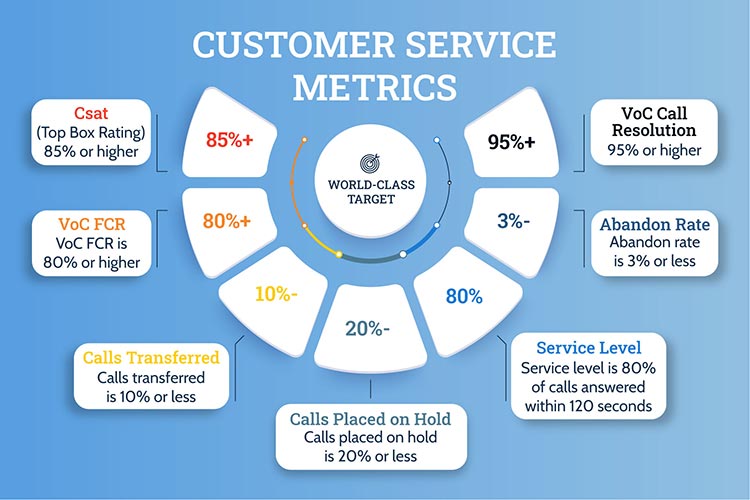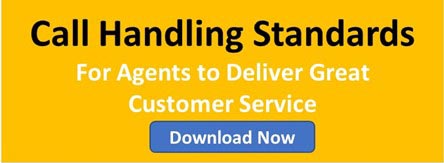Assessing Call Center Customer Service Practices
Many companies have moved beyond competing on products and prices and are now trying to differentiate based on delivering great customer service. In most cases, companies rely on the call center to provide an outstanding customer experience. SQM Group's research shows that 95% of customers will continue to do business with the organization when their call center provides First Call Resolution (FCR). Furthermore, every 1% improvement in FCR increases transactional NPS by 1.4 points for the average call center. Therefore, if a company wants to differentiate itself from its competitors based on its customer service delivery, it's imperative to have a high FCR rate that is 80% or greater.
SQM's view is that a call center should assess its operating people, processes, and technology practices to determine the effectiveness and then develop a plan of action to improve customer service. Unfortunately, there is no call center cookie-cutter approach to achieving world-class voice of the customer (VoC) service. Therefore, before you implement a best practice, assess your customer service practices by asking the below questions:
- Are you FCR obsessed with delivering great customer service?
- Do you measure, benchmark, and track FCR, call resolution, and Csat?
- Do you recognize and reward employees for FCR, call resolution, and Csat?
- Does your call center use a VoC closed-loop FCR and Csat improvement team?
- What are good customer service metrics and performance targets?
- Are your agents and managers hired based on being a customer-centric fit?
- Does your performance management system incorporate VoC data?
- Are your desktop applications effective for helping agents achieve great CX?
- Can your agents contact subject matter experts who can help them deliver FCR?
- Are your supervisors trained on coaching agents for high FCR and Csat?
- Do your QA evaluations include customer surveys and call compliance data?
- Do your call handling standards help agents deliver great customer service?
- Is your agent training program effective for helping them deliver FCR and Csat?
- Does your call center use the right agent performance metrics?
- Is your call center service recovery effective for Csat and retention?
Top 15 Proven Call Center Best Practices
It is important to emphasize that high FCR and Csat are the critical metrics for determining if a call center delivers great customer service. Here are the top 15 proven call center best practices for delivering great customer service.
- FCR Obsess for Delivering Great Customer Service.
- VoC Listening Posts for Measuring and Benchmarking FCR.
- Recognizing and Rewarding VoC Performance.
- VoC Closed-loop FCR Improvement Team.
- Customer Service Metrics for Performance Targets.
- Hiring Based on Being a Customer-centric Fit.
- Performance Management Incorporates VoC Data.
- Desktop Applications that Help Agents Achieve Great CX.
- Subject Matter Experts Help Agents Deliver FCR.
- Supervisors Trained on Coaching Agents for High FCR.
- QA Evaluations Include Surveys and Call Compliance Data.
- Call Handling Standards that Help Agents Deliver FCR and Csat.
- Have a Comprehensive Agent Training Program.
- Top 5 Call Center Agent Performance Metrics.
- Using Service Recovery for Improving Csat and Retention.

1. FCR Obsess for Delivering Great Customer Service
What is being FCR obsessed mean? Firstly, FCR obsession entails regularly listening to customers using post-call surveys to enhance and improve customer service. Secondly, FCR obsession necessitates a paradigm shift in how a company views customer service for resolving an inquiry or problem using a call center. Put differently, FCR obsession means putting your customers at the center of everything you do every day.
Our call center benchmarking research shows for every 1% improvement in FCR, there is a 1% improvement in customer satisfaction (Csat). Therefore, delivering a high FCR rate is the key to delivering great CX.
For non-FCR calls, 49% of the time, it is an organizational SoE issue out of the control of the call center business practices. Given the high organizational non-FCR SoE issues, call center leaders must partner with other departments outside the call center function to improve FCR and CX.
To help call centers improve CX, we have developed an FCR Improvement Commitment Model that call centers can use to improve FCR. This model is based on two dimensions (i.e., resource allocation requirement and the company FCR improvement focus requirement) for improving CX performance.
The combination of the two dimensions helps describe the four quadrants illustrated:
Enabler (high resource allocation and low FCR focus),
Reactor (low resource allocation and low FCR focus),
Ally (low resource allocation and high FCR focus) and
Evangelist (high resource allocation and high FCR focus).
There is no single best practice within the FCR Improvement Commitment Model, as all four practices can effectively improve FCR. Determining which FCR improvement commitment practice is appropriate for the call center will depend on the call center's FCR performance.
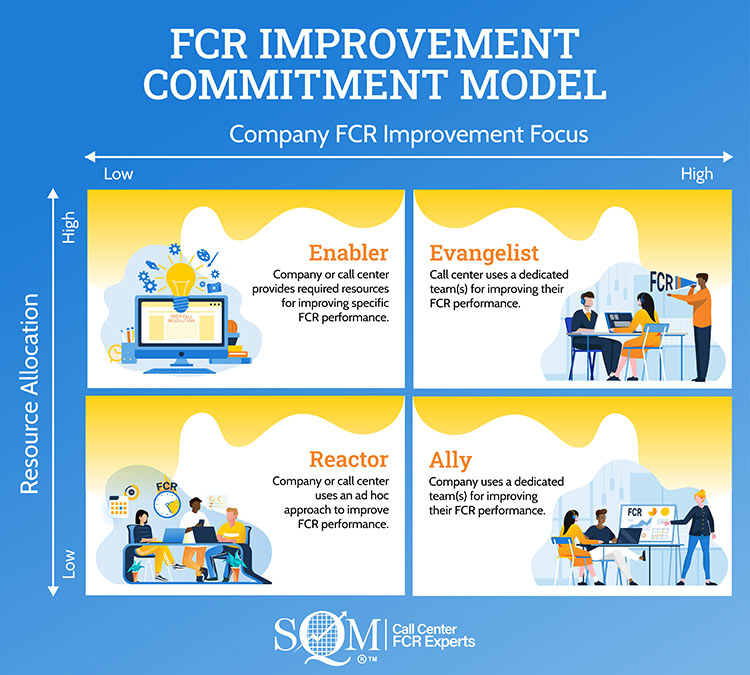

2. VoC Listening Posts for Measuring and Benchmarking FCR
When the mission is to achieve high FCR and deliver great customer service, using the VoC listening posts is a must. Call centers that provide outstanding CX have one thing in common, they use VoC listening posts to measure, track, benchmark, and improve FCR and customer service. They understand the best way to provide outstanding CX is to tap into VoC listening posts.
Furthermore, they know if you are willing to listen, customers will tell you just about everything you need to know to improve your CX and FCR. More importantly, VoC leaders action customer feedback opportunities to improve FCR and customer service. According to Gartner stat: 95% of companies collect customer feedback. Yet only 10% use the feedback to improve, and only 5% tell customers what they are doing in response to what they heard.
For a call center VoC program, a listening post captures and analyzes customers' expectations and experiences using a call center. Many managers tend to assume they understand the call center CX they deliver. VoC listening posts, such as post-call phone or email surveys, are great external measurement methods to confirm or dispel their assumptions by letting the customer judge their call center CX. Post-call phone and email surveys are the best VoC listening posts to measure, benchmark, track and improve call center FCR and customer service.
The CX listening posts are comprised of in-depth customer interviews, measuring customer relationships, and transactional surveys. Transactional-based surveys are conducted to understand touchpoint-specific CX. Conversely, relationship-based surveys are undertaken to understand interaction lifecycle stage-specific or entire CX.
The CX journey mapping interview is an in-depth interview with customers who do business with your organization and focuses on the interactions and touchpoints your customers have experienced. These interviews can occur individually or in a small focus group setting.
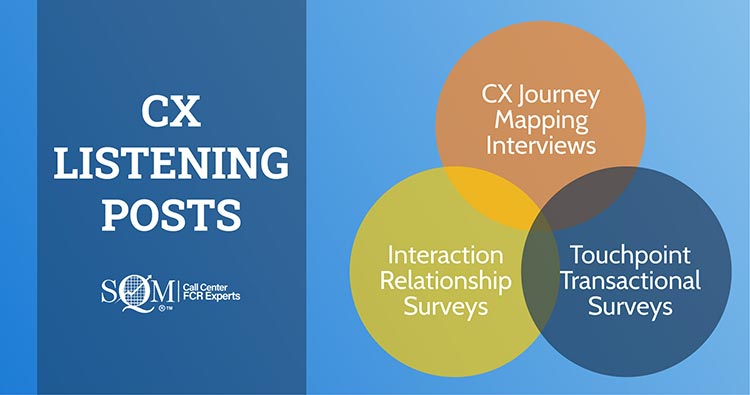

3. Recognizing and Rewarding VoC Performance
As most call center managers know, motivating agents to use the desired CX behaviors to achieve high call resolution performance and retaining the best agents are significant challenges. An effective recognition program will significantly help management motivate agents to excel at providing great CX and high call resolution and retain the top call resolution performing agents.
SQM research shows that 40% of customers whose call was not resolved felt the agent could have done more to resolve their call. In many cases, the Agents were not motivated to use the desired customer service behaviors to resolve customer calls. In other words, from a customer's point of view, it was a will issue rather than a skill issue.
At SQM, we believe the Regence BlueCross BlueShield Service Hero recognition program to be a best practice for recognizing agents for their CX performance. Any call can be nominated to be a winning Service Hero interaction. Often calls are nominated by a leader as they listen to calls and identify situations where the agent is truly going above and beyond.
The leadership team first reviews the calls in their respective locations. Then, every quarter after vetting within each location, the best Service Hero interaction nominations are sent to the next level of review. The final selection is made by their four business unit Plan Presidents and other senior executives. The Plan Presidents and senior executives listen to the calls and rank them based on the agents' ability to create a truly outstanding experience for their customers.
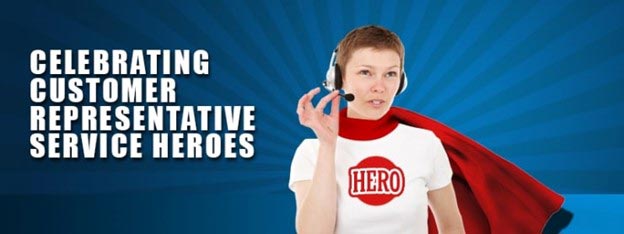

4. VoC Closed-loop FCR Improvement Team
The VoC closed-loop improvement process is a well-accepted ongoing business practice for identifying what areas to improve and for implementing people, process, and technology practices that will improve FCR and customer service performance on an ongoing basis. The basic premise of the VoC Closed-Loop process is to form an FCR improvement team and use VoC data (e.g., post-call survey and CRM/call recording systems) to identify, analyze, and develop solutions to action for improving customer service.
Call center leaders are increasing investments in VoC programs and software that employ a VoC Closed-Loop process. At SQM, our customer service management software has a VoC Closed-Loop improvement process feature that consists of four steps – Identify, Develop, Check, and Act (IDCA) to improve FCR and customer service performance.
1. Identify - repeat call reasons to improve by measuring FCR and Csat performance
2. Develop - a solution and implement a test pilot to reduce repeat call reasons
3. Check - to see if the test pilot was successful by measuring changes in FCR
4. Act - on customer feedback by implementing a standardized improvement plan for reducing repeat call reasons for the entire call center
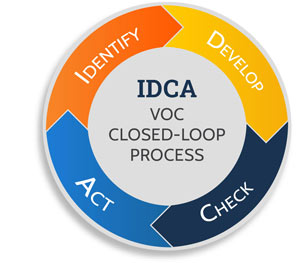

5. Good Customer Service Metrics Performance Targets
Many senior call center managers ask SQM the following customer service questions, "What key performance indicators (KPIs) are most important, what are the world-call targets, and what is the best customer service employee accountability KPIs?" SQM's view is that only a few of the below world-class customer service targets used for KPIs should be used to create accountability from the agent to the senior VP level.
The typical VoC service metrics used to create accountability from the agent to the senior VP call center level are 'FCR,' 'call resolution,' and 'overall customer satisfaction with the call center or the agent.' Any of these three metrics meets all seven characteristics of an effective KPI. The transactional Net Promoter Score and Net Retention Index metric are also common metrics used but less so.
The other customer service metrics and targets are worth pursuing and creating accountability. However, they should have less importance for employee accountability at all levels because they have fewer characteristics of an effective KPI. Below are the world-class customer service targets for commonly used KPIs.

6. Hiring Based on Being a Customer-centric Fit
Currently, the agent turnover rate of 35% is the highest turnover percentage we have ever measured in over 25 years of benchmarking this metric. Furthermore, agent turnover is the biggest issue hindering call centers in terms of delivering great customer service. A best practice for selecting an agent is to hire based on customer-centric fit. Put differently, hire for attitude versus aptitude. Furthermore, the average cost to hire and train a new agent is $8,100, and it takes three to six months for a new agent to perform at the same VoC metrics level as an agent who has worked in the call center for at least one year.
Identifying candidates who are a good fit for the agent job to deliver great customer service can be an enormous undertaking. The chances of hiring agents that will provide world-class customer service can be increased by using the following agent selection four steps:
- Pre-Interview Screening
- Personality/Behavioral Test
- Job Simulation
- Face-to-Face Interview
The interview team, or just the supervisors, should review all of the information gathered from the first three steps of the agent selection process before they meet with the candidates.
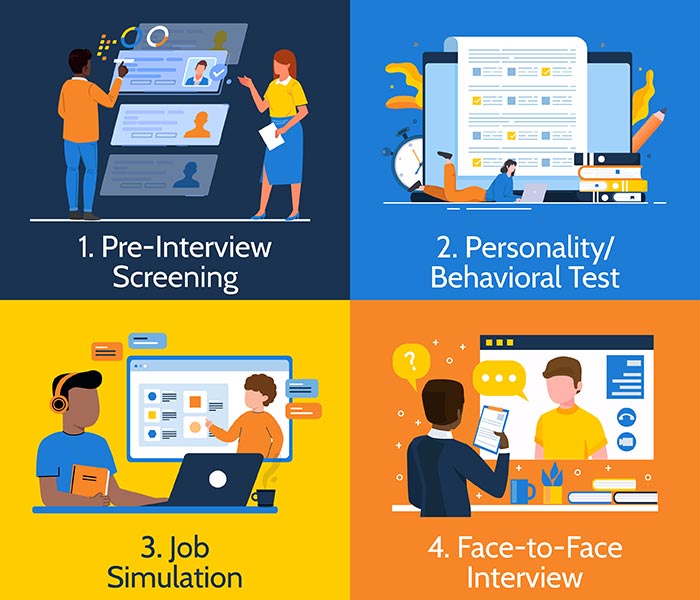
Again, the face-to-face interview should be viewed as the final step in determining whether or not the candidate should be hired for the agent job. This interview questionnaire could be shortened and used in the pre-interview screening step. This questionnaire asks FCR-focused questions and shows the type of information that can be expected as a response.
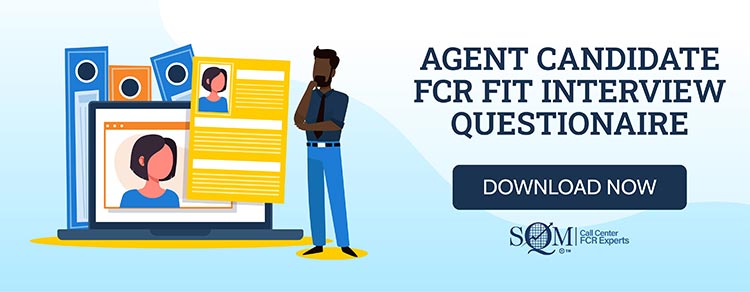
7. Performance Management Incorporates VoC Data
Implementing a VoC Performance Management System has been one of the quickest ways to improve FCR and has provided the most significant increases in FCR performance. It has also been the most consistent best practice for improving FCR and customer service. Agent VoC Performance Management System uses VoC metrics such as FCR, call resolution, and Csat based on post-call survey data for creating agent accountability, performance reporting, improvement plans, annual performance appraisals, and compensation pay.
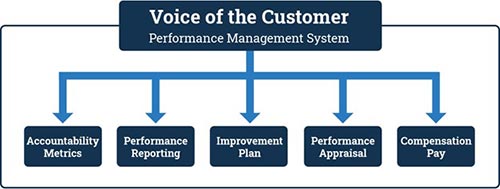
Most of our clients use a balanced scorecard approach for creating agent accountability. Some of our clients who use a balanced scorecard have the metrics weighted towards VoC metrics, which we consider a best practice. An effective Agent VoC Performance Management System uses customer service management software for reporting agent VoC performance. The performance improvement plan (PIP) is a process for dealing with agents who have not performed to the call center's VoC standards. When conducting annual agent performance reviews, the appraisal form must be structured to convey what is truly important to the call center, what is expected of agents, their performance, and opportunities for improvement. A VoC Performance Management System uses extrinsic rewards (e.g., pay raises, bonuses, benefits) and intrinsic rewards (e.g., recognition for performing it well) to motivate agents to achieve high call resolution and Csat performance.

8. Desktop Applications that Help Agents Achieve High FCR and Great CX
Most call centers have had limited success with improving FCR due to initiating new desktop applications. However, SQM clients who have improved their FCR because of a new desktop application have done so by focusing on improving FCR. Call centers are so complex that they require many different desktop applications to support agents handling calls to provide FCR and a great CX. The three primary agent desktop applications essential for consistently delivering FCR, great CX, and achieving a significant return on an agent's desktop applications investment are:
Unified Agent Desktop
Connects all of the call center's desktop applications that agents typically access and brings them into a single application. This approach makes it easier for an agent to resolve the call cost-effectively, saving time by not using multiple applications.

Customer Relationship Management
Used for servicing customer inquiries or problems. The CRM provides agents with information about all customer interactions and is updated by agents in a standardized format to capture customer interactions and commitments.
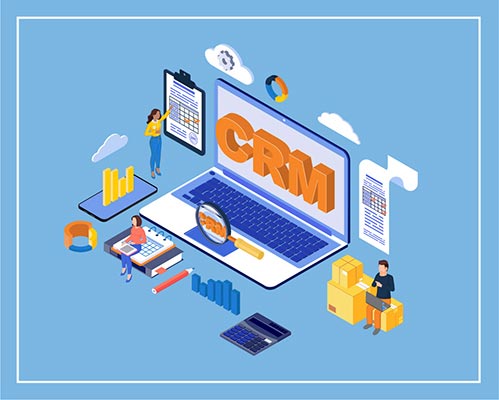
Knowledge Management Tool
Used to assist agents in resolving customer calls. Agent knowledge is central to the customer service experience to answer customer inquiries and provide all necessary information needed to resolve a customer's inquiry. If customers already had the knowledge, they would not need to call.
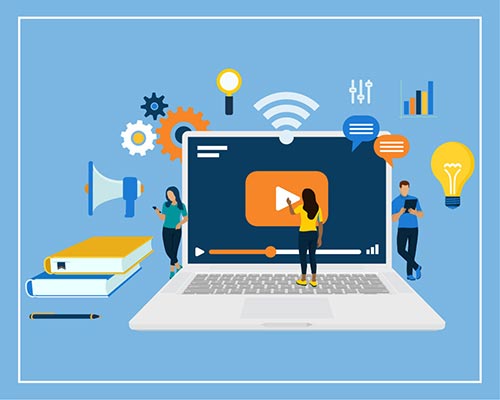

9. Subject Matter Experts Help Agents Deliver FCR
Call center helpdesk agents assists frontline customer service agents in resolving calls or taking over a complex or an escalation call from the original frontline agent to resolve the customer inquiry or problem. In most cases, helpdesk agents are subject matter experts and are capable of helping frontline agents and customers resolve their inquiries or issues. Additionally, helpdesk agents support email, phone, and chat contact channels.
The helpdesk support queue plays a vital role in helping customer service agents and customers resolve calls. For many organizations, the call center helpdesk agents are the last line of defense for handling customer complaints and reducing customer churn. SQM's research clearly shows that if helpdesk calls are managed effectively, Csat does not drop. However, there is a 15% drop in Csat for each additional call required to resolve the customer's call on average. Furthermore, the average call center FCR is 19% lower when the call is transferred to a helpdesk agent. 95% of customers expressed intent to continue doing business with an organization when FCR is achieved.
For most call centers, customer calls that helpdesk agents handle are from the frontline agent asking for assistance versus the customer calls being transferred to them. Therefore, in many cases, the helpdesk queue has two tiers of helpdesk agents:
Tier 1 helpdesk agents assist frontline customer service agents with resolving their customer calls and are not in direct contact with the customer. In other words, they act as an internal helpdesk for frontline agents.
Tier 2 helpdesk agents handle complex or escalated calls by having the frontline agents transfer the call to them to resolve the customer's call directly.
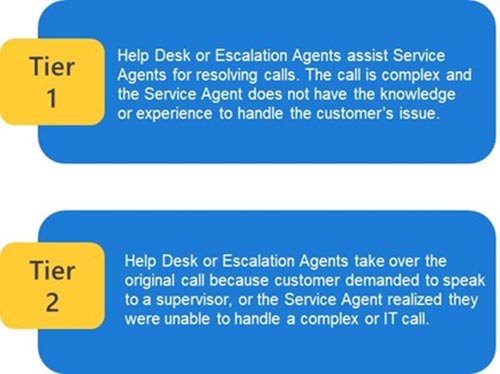

10. Supervisors Trained for Coaching Agents for High FCR
SQM agrees with the vast majority of call center professionals' opinion that coaching Agents is critical. However, there is an opportunity to be more effective at Agent coaching to improve FCR, call resolution, and customer service. Given the excellent opportunity to improve Agent call resolution and Csat coaching, all supervisors should be trained on a VoC Agent Coaching model.
The below figure shows an ongoing four-step VoC Agent Coaching model (i.e., 1. Call Assessment, 2. Develop Action Plan, 3. Agent Communication, and 4. Agent Feedback) and tips for helping Agents improve call resolution and customer service performance.
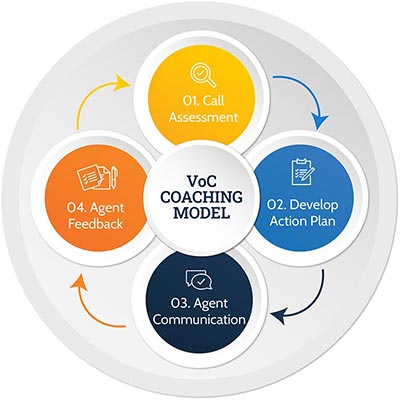
The call assessment process is an ongoing customer survey business practice. When a supervisor assesses Agent calls, they need to determine the strengths and weaknesses for resolving calls and Csat.
The supervisor develops an action plan for improving the agent's performance for two VoC metrics (e.g., call resolution and Csat). The agent should only be accountable for VoC metrics they have a direct impact on.
The supervisor communicates with the agent about their call resolution and Csat performance in a private setting. The supervisor starts the coaching session using questions (e.g., What areas do you think you did well on?, What areas do you think you need to improve on?)
The agent consistently receives feedback on areas identified in the action plan to check progress. The supervisor provides the agent feedback on specific positive behaviors and behaviors that still need improvement.

11. QA Evaluations Include Surveys and Call Compliance Data
Customer Quality Assurance (CQA) combines call compliance metrics, judged by a QA evaluator, and service quality metrics, judged by a customer via a post-call or email customer survey. CQA is based on the premise of letting the customer be the judge of their own experience when contacting an organization and is one of the best practices for driving improvements in the FCR rate and customer service.
If CQA is properly implemented, a contact center can expect up to a 10% improvement in FCR. That means for an average call center performing at a 70% FCR rate, if they improved by a 10% FCR rate, they would be performing at the world-class FCR rate of 80%.
CQA uses VoC data to judge call quality to enhance, not replace, the established call monitoring process. The customer survey information alone cannot replace the entire QA process because there are some call center metrics that the customer simply cannot judge (e.g., compliance, the accuracy of information). Thus, it is still necessary for the call center monitoring team to evaluate these metrics or use analytical tools to determine call compliance.
The most effective CQA program for the call center is a two-part process that blends external VoC evaluation with internal call evaluations. Download the CQA evaluation form now. First, each agent receives a CQA evaluation report that consists of both the customer survey and the call compliance results for the same call. As shown by the below figure, the CQA evaluation scoring is a total of 100 points, comprised of:
CQA Evaluation Scoring Breakdown
- 60 points are available based on customer survey results, and 40 points are available based on call compliance metrics.
- Of the 60 points allocated for customer survey results, 40 points for call resolution, and 20 for customer satisfaction.
- Of the 40 points allocated for call compliance metrics, 30 are customer-focused, and 10 are organization-focused.
- CQA point allocation is 90% skewed towards customer metrics (i.e., 60 points from the customer survey metrics and 30 points from call compliance metrics).
- Having 90% of the CQA evaluation form allocated towards the customer's experience sends the message to agents that the customer's experience (e.g., call resolution, Csat) is what really matters in the CQA evaluation program and to the organization.
Customer Quality Assurance Evaluation Scoring
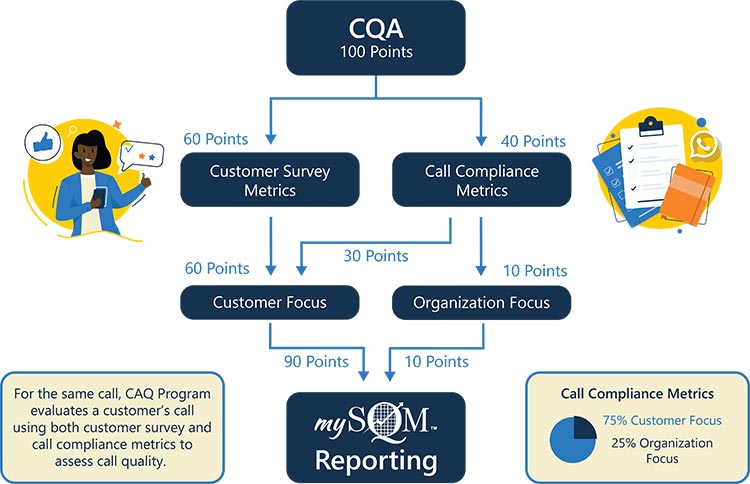

12. Call Handling Standards that Help Agents Deliver FCR and Csat
The Moments of Truth (MoT) concept was developed by Jan Carlzon1 when he was CEO of Scandinavian Airlines in 1986. In his book, Moments of Truth, Jan Carlzon defines Moments of Truth as, "Anytime a customer comes into contact with any aspect of a business, however remote, is an opportunity to form an impression."
To help agents gain effective call handling practices, SQM has developed a Call Resolution Delivery Model that defines the customer service standards an agent should follow to successfully resolve customer calls at the world-class level of 95%. Therefore, at SQM, we developed call handling standards-based MoT that customers experience using a call center to help them resolve an inquiry or problem. The call handling MoT is based on understanding, helping, caring, and resolving a customer interaction.
Understand Me – The agent determines and confirms the reason(s) for the customer's call by actively listening, probing, and clarifying in order to ensure understanding as well as acknowledging call history and documenting the conversation.
Help Me – The agent expresses and demonstrates a willingness to help a customer by letting them know that they can help them, providing accurate and complete information, keeping them focused on the inquiry, taking the necessary time to help the customer, and educate them with solution options.
Care About Me – Agent uses a friendly, enthusiastic, and warm voice tone, builds rapport shows empathy for the customer's situation, is patient and honest, and expresses appreciation for the customer's business.
Resolve Me – The agent resolves the customer's inquiry or problem by answering questions, solving problems, using authority and taking ownership, providing fair treatment summarizes call, communicates next steps, and confirms that the call is resolved.
Call Resolution Delivery MoT Standards
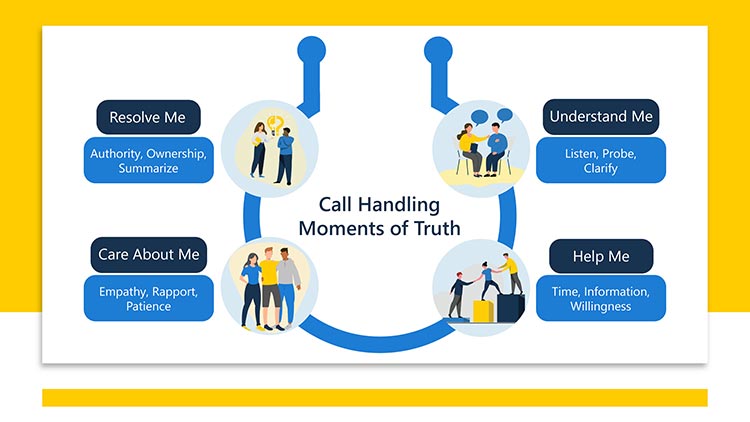
We define call handling standards, share associated behaviors, and we provide word choices and phrases for agents to deliver great customer service. Download now.

13. Have a Comprehensive Agent Training Program
The 30% of customers who experienced non-FCR, agents are the source of error (SoE) for approximately 40% of those calls. Of that, only 6% is due to a lack of agent soft skills (e.g., was not polite or did not care, or was rude). On the other hand, agents who lack customer handling skills (e.g., unable to fix the issue, did not have product or service knowledge, or could not provide a satisfactory solution) represent 94% agent SoE.
Clearly, call handling represents a much bigger opportunity to improve than soft skills to provide great customer service. Yet, many call center leaders think that soft skills have a much more significant impact and are surprised at how low the impact is on customer service. SQM's view is that improving agent soft skills has a much more positive impact on customer care versus customer service.
Furthermore, many call center managers are unaware of the impact of repeat calls on their Csat, agent job satisfaction, and customer retention. SQM is often asked: "How can I get my Agents to improve their call resolution and Csat performance?", "How do I reduce customer defections?", "How can I improve these issues as soon as possible?" The answer to these questions can be found by implementing a Call Resolution Delivery Agent Training Program.
The following are call resolution training tips to help Agents improve FCR and customer service:
- Train supervisors on how to coach agents to improve Voice of the Customer (VoC) performance and to engage agents so they are motivated to improve FCR, call resolution, and Csat
- Budget and adequately plan for providing Agent call resolution two-day training
- Provide call resolution training for both new hires and existing Agents
- Hire Agents with a customer-centric attitude and train for call resolution skills
- Use job shadowing and peer mentoring for Agent new hires or poor Agent VoC performers, using Agents as the mentor with the highest call resolution and Csat performance as the coach
- Incorporate VoC repeat call reasons and solutions into new hire and ongoing Agent training programs
- Provide call resolution classroom and/or e-learning training
- Use Agent VoC customer service reporting software tool that can provide a dashboard view of call resolution, Csat performance and identifies opportunities to improve CX
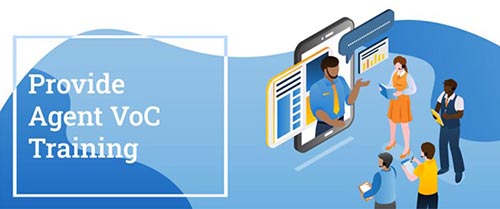

14. Top 5 Call Center Agent Performance Metrics
SQM's experience is that most call centers that improve customer service do so by creating agent accountability for customer service metrics and reducing the agent source of errors for repeat calls to resolve an inquiry or problem. Moreover, improving customer service based on motivating and creating more agent accountability tends to be quicker than fixing the organizational source of error issues.
Organizations trying to be more customer-centric are not holding their agents accountable for only efficiency KPI metrics (e.g., AHT, schedule adherence, and calls handled) but emphasizing customer service effectiveness KPI metrics (e.g., FCR, Csat, and retention). As a result, in many cases, customer-centric call centers focus on effective KPI metrics, and they have dramatically transformed an agent's performance metrics used for their goals and accountability.
When call centers rely primarily on agent efficiency metrics, it can create poor agent behaviors that negatively impact CX. On the other hand, when call centers emphasize agent effectiveness metrics, their CX improves and adds more value to the enterprise-wide strategic customer service goals.
SQM Group's benchmarking of over 500 leading North American call centers' research showed the top 25% performing call centers for customer service (e.g., high FCR and Csat) have in common is the emphasis on using agent effectiveness performance metrics. Therefore, high-performing call center agents are primarily held accountable for effectiveness metrics such as FCR, call resolution, and Csat.

First Call Resolution is a metric that measures an agent's performance for resolving customer interactions on the first call or contact, eliminating the need for follow-up contacts. Call centers use internal and external methods to measure FCR.
The customer satisfaction metric quantifies how satisfied customers are with agents for helping them with resolving their interactions. The agent Csat metric is viewed as a KPI and is the most popular customer service effectiveness metric used by call centers.
The Net Retention Index (NRI) metric is used to help determine interaction customer retention when using a call center. An interaction NRI is based on a customer using a call center, which differs from the traditional NRI based on the customer's overall relationship with a company.
Customer Quality Assurance (CQA) combines call compliance metrics, judged by a QA evaluator, and service quality metrics, judged by a customer via a post-call or email customer survey. The CQA evaluation scoring is 100 points, comprised of 60 points available based on customer survey results and 40 points available based on call compliance metrics. CQA is one of the best practices for driving improvements in the FCR rate and customer service.
Average Handle Time (talk time + wrap-up time) measures how long an agent spends completing customer interactions. Many call centers evaluate agent AHT because they want to reduce cost per call and call wait times. In many cases, agents that have lower AHT are more efficient and effective at resolving customer interactions. Therefore, they tend to have higher FCR or call resolution performance.

15. Using Service Recovery for Improving Csat and Retention
SQM's research shows that 14% of customers who call a contact center define their call as a complaint. In fact, most contact centers believe that their customer complaint calls are less than 5%. It is SQM's experience that complaint calls are significantly underreported.
A call center's escalation support queue's primary purpose is to have those agents working in that queue either assist customer service agents in resolving a call or resolve a complex or a complaint call by talking to the customer directly. The escalation (sometimes called retention, helpdesk, or office of the president) agent support queue is the last line of defense in many cases for resolving a complex call or a customer complaint and retaining a customer.
Many angry or upset customers have very low expectations that their issue or problem will get resolved to their satisfaction. However, dealing with an angry customer represents an excellent opportunity to meet or exceed their expectations to resolve the issue or problem. Put differently, a customer complaint is a gift because you get the chance to deliver service recovery and learn from mistakes.
SQM research shows that when a call is unresolved, 1 out 5 customers will defect. The following is an effective complaint handling three-step process an agent or escalation agent can use for service recovery when handling an angry or upset customer.
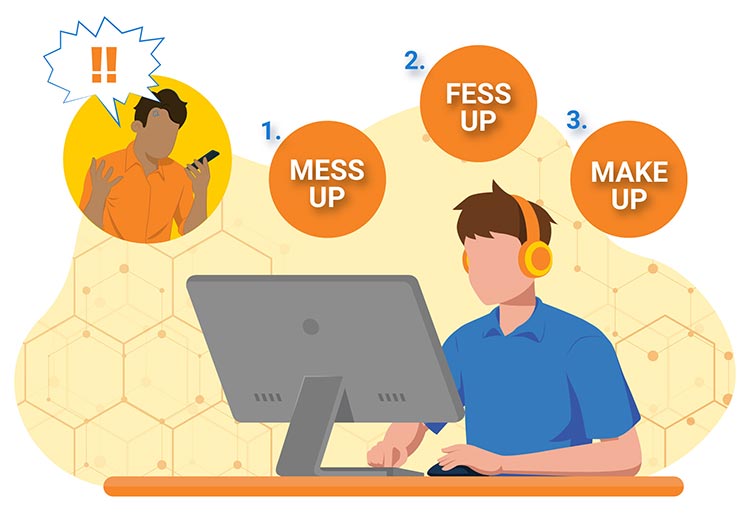
Mess Up
Allow the customer to tell their side of the story and vent their frustration without being interrupted. The agent acknowledges that they have heard the customer by using words such as uh-huh, hmm, I see, and tell me more. Listening to the customer and letting them vent allows them to calm down.
Fess Up
Ask questions to ensure understanding of the issue or problem. Agent restates the issue or problem to confirm that they fully understand. Agent apologizes for the organization's mistake or expresses empathy for the customer's situation. If a full agreement between the customer and agent cannot be reached on the issue or problem, try to seek a partial agreement on the issue or problem to defuse the customer's anger.
Make Up
Resolve the customer's issue or problem to their satisfaction. Many customers have low expectations that their issues will get resolved to their satisfaction. By providing a solution or solution options to resolve their issue or problem, you have an opportunity to meet or exceed the customer's expectations. The agent should confirm with the customer that there is agreement that the solution or solution options will resolve the customer's issue or problem (e.g., Have I resolved your issue or problem?).
Quick Related Links
First Call Resolution Definition First Call Resolution PPT First Call Resolution Benefits
First Call Resolution Strategies First Call Resolution Video Helpdesk First Call Resolution FCR Improvement Commitment Model What is a Good FCR Rate? FCR Improvement Tips Top 10 Metrics and KPIs FCR Measurement Case Study Good To Great Service Csat Comprehensive Guide Customer Quality Assurance

